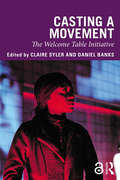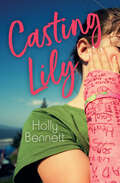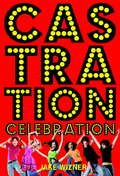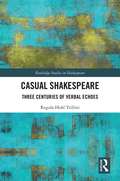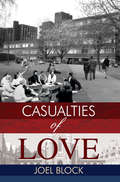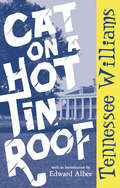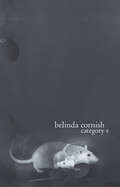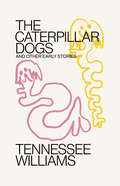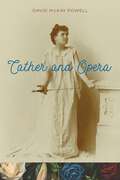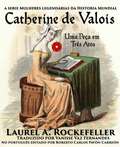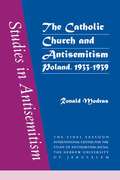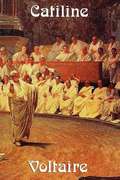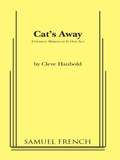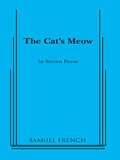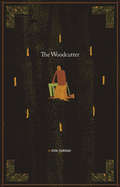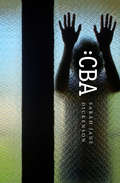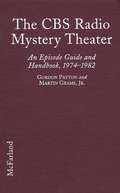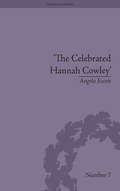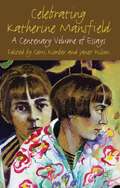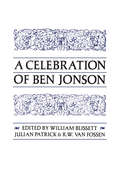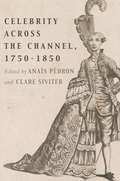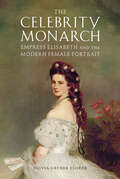- Table View
- List View
Casting a Movement: The Welcome Table Initiative
by Claire Syler Daniel BanksCasting a Movement brings together US-based actors, directors, educators, playwrights, and scholars to explore the cultural politics of casting. Drawing on the notion of a "welcome table"—a space where artists of all backgrounds can come together as equals to create theatre—the book’s contributors discuss casting practices as they relate to varying communities and contexts, including Middle Eastern American theatre, disability culture, multilingual performance, Native American theatre, color- and culturally-conscious casting, and casting as a means to dismantle stereotypes. Syler and Banks suggest that casting is a way to invite more people to the table so that the full breadth of US identities can be reflected onstage, and that casting is inherently a political act; because an actor’s embodied presence both communicates a dramatic narrative and evokes cultural assumptions associated with appearance, skin color, gender, sexuality, and ability, casting choices are never neutral. By bringing together a variety of artistic perspectives to discuss common goals and particular concerns related to casting, this volume features the insights and experiences of a broad range of practitioners and experts across the field. As a resource-driven text suitable for both practitioners and academics, Casting a Movement seeks to frame and mobilize a social movement focused on casting, access, and representation.
Casting Lily (Orca Limelights)
by null Holly BennettOne bad decision jeopardizes Ava's chances of being able to perform on opening night. Fourteen-year-old Ava is thrilled when she lands a part in a play based on the true story of orphans sent to Canada in the 1800s to work on farms. But is she good enough to hold her own in a professional production? As the rehearsal pressures crank up, Ava struggles with her character, with the vocal demands of outdoor theater and with the annoying ego of her castmate Kiefer. But as she learns more about the historical Lily on which her part is based, things begin to fall into place. This short novel is a high-interest, low-reading level book for middle-grade readers who are building reading skills, want a quick read or say they don’t like to read! The epub edition of this title is fully accessible.
Castration Celebration
by Jake WiznerIt's High School Musical--rated R! When the girl who's foresworn men meets the boy who's devoted himself to picking up women, there's bound to be drama--perfect for a six-week summer program devoted to the arts. Olivia's summer goal: to write a musical that censures men with wandering eyes. Max's summer goal: to hone his acting skills, along with his talent for attracting the ladies. Before camp is over, they'll perform Olivia's musical onstage and in real life--though the ending may turn out differently than either expects. Jake Wizner's story within a story takes the battle of the sexes to a whole new level in a bawdy, uproarious romp that's laugh-out-loud fun.
Casual Shakespeare: Three Centuries of Verbal Echoes (Routledge Studies in Shakespeare)
by Regula Hohl TrilliniCasual Shakespeare is the first full-length study of the thousands of quotations both in and of Shakespeare's works which represent intertextuality outside of what is conventionally appreciated as literary value. Drawing on the insights gained as a result of a major, ongoing Digital Humanities project, this study posits a historical continuum of casual quotation which informs Shakespeare's own works as well as their afterlives. In this groudbreaking, rigorous analysis, Dr. Regula Trillini offers readers a new approach and understanding of the use and impact quotes like the infamous, 'To be or not to be,' have had througout literary history.
Casualties of Love
by Joel BlockIt is the 1960's, love is loose and a co-ed in a Southern University town is assaulted. Hidden behind the incident is a secret that she feels too vulnerable to reveal. Instead, she turns to her lover to help her seek revenge. Her lover, a scholarship student, has lived a life stifled by fear; his memories are not from real life, but from the fiction he loves and has hidden behind. His only close friends are the characters in the books he reads and, of course, those friendships are one-way. He is now faced with the decision to stand for something, and defend his girlfriend, or to allow a biased legal system betray her. The lovers are torn apart by their differences. The young man thought he had finally found a woman he could trust. He finds out that she is not the woman he thought her to be, and he is not the man he believed himself to be; he is more than he ever imagined. The young woman thought she could never give her heart to love and ends up giving everything. If it's been said that every generation gets the scandal it deserves, then it might be said that every town breeds the kind of crime it can accommodate, and we all eventually confront the challenge meant for us.
Cat on a Hot Tin Roof
by Edward Albee Tennessee WilliamsThe definitive text of this American classic--reissued with an introduction by Edward Albee (Who's Afraid of Virginia Woolf? and A Delicate Balance) and Williams' essay "Person-to-Person." Cat on a Hot Tin Roof first heated up Broadway in 1955 with its gothic American story of brothers vying for their dying father's inheritance amid a whirlwind of sexuality, untethered in the person of Maggie the Cat. The play also daringly showcased the burden of sexuality repressed in the agony of her husband, Brick Pollitt. In spite of the public controversy Cat stirred up, it was awarded the Pulitzer Prize and the Drama Critics Circle Award for that year. Williams, as he so often did with his plays, rewrote Cat on a Hot Tin Roof for many years--the present version was originally produced at the American Shakespeare Festival in 1974 with all the changes that made Williams finally declare the text to be definitive, and was most recently produced on Broadway in the 2003-04 season. This definitive edition also includes Williams' essay "Person-to-Person," Williams' notes on the various endings, and a short chronology of the author's life. One of America's greatest living playwrights, as well as a friend and colleague of Williams, Edward Albee has written a concise introduction to the play from a playwright's perspective, examining the candor, sensuality, power, and impact of Cat on a Hot Tin Roof then and now.
Category E
by Belinda CornishI didn’t think we got to have names.Two human test subjects—Corcoran, a half-blind paraplegic, and Filigree, a clinical psychopath—coexist in a laboratory cell. They are sterilized, property of the state, and utilized for the benefit of higher-valued citizens. In their cell are two beds and two chairs. But then Millet arrives. Within thirty-six hours there will only be two again. In the meantime, they play Monopoly, try to figure out who is next door, eat what is given to them, and do their best not to kill each other.This black comedy takes a wry and unsentimental look at the cavalier cruelties of animal science and asks how we place value on life.
Caterpillar Dogs: And Other Early Stories
by Tennessee WilliamsSeven previously unpublished stories of the Great Depression by America’s poet laureate of the lost These tales were penned by one Thomas Lanier Williams of Missouri before he became a successful playwright, and yet his voice is unmistakable. The reliable idiosyncrasies and quiet dignity of Williams’s eccentrics are already present in his characters. Consider the diminutive octogenarian of “The Caterpillar Dogs,” who may have just met her match in a pair of laughing Pekinese that refuse to obey; the retired, small-town evangelist in “Every Friday Nite is Kiddies Nite,” who wears bright-colored pajamas and receives a message from God to move to St. Louis and finally, finally go to the movies again; or the distraught factory worker whose stifled artistic spirit, and just a soupçon of the macabre, propel the drama of “Stair to the Roof.” Love’s diversions and misdirections, even autoerotic longings, are found in these delightful lagniappes: in “Season of Grapes,” the intoxicating ripeness of summer in the Ozarks acquaints one young man with his own passions, which turn into a fever dream, and the first revelation of female sexuality blooms for a college boy in “Ironweed.”Is there such a thing as innocence? Apparently in the 1930s there was, and Williams reveals it in these stories.
Cather and Opera
by David McKay PowellThroughout her fiction, Willa Cather mentioned forty-seven operas. References to opera appear in all but three of her twelve novels and in roughly half of her short stories. Despite a dearth of musical education, Cather produced astute writing about the genre beginning in her earliest criticism and continuing throughout her career. She counted opera stars among her close friends, and according to Edith Lewis, her companion throughout adulthood, the two women frequently visited the theater, even in the early days, when purchasing tickets to attend performances proved a financial sacrifice. Melding cultural history with thoughtful readings of her works and discussions of opera’s complex place in turn-of-the-century America, David McKay Powell’s Cather and Opera offers the first book-length study of what drew the writer so powerfully and repeatedly to the art form. With close attention to Cather’s fiction and criticism, Powell posits that at the heart of both her work and the operatic corpus dwells an innate tension between high artistic ideals and popular acceptance, often figured as a clash between compositional integrity and raw, personal emotion. Considering her connection to opera in both historical and intertextual terms, Cather and Opera investigates what operatic references mean in Cather’s writing, along with what the opera represented to her throughout her life.
Catherine de Valois, Uma Peça em Três Atos
by Vanisse Vaz Fernandes Laurel A. RockefellerA Guerra fez a rainha da Inglaterra. Seu amor por um galês, a fez imortal. Adaptado da criativa biografia não-ficção de mesmo nome, Catherine de Valois, conta a história de uma das rainhas mais fascinantes do século 15, levando o público para além de Henry V e Agincourt, para descobrir a verdadeira mulher que você pensou que conhecia desde de Shakespeare em "Henry V . "
The Catholic Church and Antisemitism
by Ronald ModrasInterwar Poland was home to more Jews than any other country in Europe. Its commonplace but simplistic identification with antisemitism was due largely to nationalist efforts to boycott Jewish business. That they failed was not for want of support by the Catholic clergy, for whom the ''Jewish question'' was more than economic. The myth of a Masonic-Jewish alliance to subvert Christian culture first flourished in France but held considerable sway over Catholics in 1930s Poland as elsewhere. This book examines how, following Vatican policy, Polish church leaders resisted separation of church and state in the name of Catholic culture. In that struggle, every assimilated Jew served as both a symbol and a potential agent of security. Antisemitism is no longer regarded as a legitimate political stance. But in Europe, the United States, and the Middle East, the issues of religious culture, national identity, and minorities are with us still. This study of interwar Poland will shed light on dilemmas that still effect us today.
Catiline
by VoltaireIn his preface to this play Voltaire says: "The learned will not here meet with a faithful narrative of Catiline's conspiracy: a tragedy, they very well know, is not a history, but they will see a true picture of the manners of those times: all that Cicero, Catiline, Cato and Cæsar do in this piece is not true, but their genius and character are faithfully represented: if we do not there discover the eloquence of Cicero, we shall at least find displayed all that courage and virtue which he showed in the hour of danger. In Catiline is described that contrast of fierceness and dissimulation which formed his real character; Cæsar is represented as growing into power, factious, and brave; that Cæsar who was born at once to be the glory and the scourge of Rome." Wilder Publications is a green publisher. All of our books are printed to order. This reduces waste and helps us keep prices low while greatly reducing our impact on the environment.
The Cat's Away
by Cleve HauboldAnother play woven around another set of daft characters from San Francisco's Union Street. Crusty but confused Estelle Bentwood insists her cat, Miss Pearl, has been writing naughty sea faring novels on her Underwood. Her niece, Mary, and Horace, the long suffering waiter, almost talk her out of the notion-- when an excitable publisher shows up with a manuscript, a contract, certified check and a passion for Miss Pearl! There's laughable confusion to comic chaos as everyone tries to close the deal in a different way. In the unexpected climax. Miss Pearl herself appears-- and her unlikely visit is a shock to everyone. Lovable off beat characters and an ingenious plot full of surprises makes this play an audience pleaser.
The Cat's Meow
by Steven PerosFull Length, Comic Drama / 6 m, 8 f, Doubling is possible / Based on the true story of a mysterious Hollywood death, The Cat's Meow offers a fascinating cross section of Jazz Era characters who intersect for one notorious weekend on board William Randolph Hearst's yacht in 1924. The play was adapted for film in 2002, with a screenplay by the author, directed by Peter Bogdanovich, and starring Kirsten Dunst, Eddie Izzard, and Edward Herrmann. Weekend guests include: Charlie Chaplin, who has been carrying on with movie star Marion Davies, a secret known to Davies' paramour, the married - and much older -- Hearst; and movie mogul Thomas Ince, who is hoping to revive his flagging fortunes by forming a partnership with Hearst. Playing with fire, Ince tries to convince Hearst that he can handle both Marion's movie career... and her private life as well. During its 1997 Los Angeles premiere, audiences and critics were both entertained and moved by this darkly comic morality play, laced with clandestine romance, Hollywood excess, and steadily heating tensions, which erupt in a shocking act of violence. "Hearst Yacht Mystery is The Cat's Meow...A stylish and sardonically funny expose of corrupt Tinseltown values." -Los Angeles Times
The Cave Painter & The Woodcutter
by Don HannahDianne is a printmaker who derives her imagery from pre-history—Neanderthal teeth, the Jericho skulls, old bones. Too many people close to her have passed away, and her only son has rebelled by embracing a life of religious fundamentalism. The Cave Painter is a funny, moving one-woman show about being an artist and dealing with loss. In The Woodcutter, a scruffy, exhausted man is lost in the woods at nightfall with only a few sentimental objects in his pockets. Alone in a clearing, he unloads his thoughts to the surrounding wilderness, ranting and raging, unravelling a story of a troubled past and of the family he adores, eventually coming to terms with the impossible truth of what he's done.
CBA
by Sarah Jane DickensonTrialled in schools with young people, CBA is a play that asks the really urgent questions of today. It seems so private, just you and the screen. You click 'send'. Then the whole world crashes through. Keisha has a secret, Georgia has a security problem and Tom is afraid to speak out. When should you tell someone's secret? How can jokes go so wrong? Fast paced and thought-provoking , CBA examines growing up in a digital world.
The CBS Radio Mystery Theater: An Episode Guide and Handbook to Nine Years of Broadcasting, 1974-1982
by Gordon Payton Martin GramsAlmost every evening for nine years during the late 1970s and early 1980s, the CBS Radio Mystery Theatre brought monsters, murderers and mayhem together for an hour. Created, produced and directed by Himan Brown, the series remains a landmark in radio drama. This book is a detailed history and episode guide to the show. Descriptive information includes exact titles, airdates and rebroadcast dates, episode numbers, cast lists, writer and adapter credits, and a storyline synopsis. This material comes directly from CBS press releases in order to insure complete accuracy. Also included wherever possible are information about the actors and actresses, quotes from performers and writers (many from personal interviews), anecdotes about various scripts and sound effects, and other notes of interest.
The Celebrated Hannah Cowley: Experiments in Dramatic Genre, 1776–1794 (Gender and Genre)
by Angela EscottHannah Cowley (1743–1809) was a very successful dramatist, and something of an eighteenth-century celebrity. New critical interest in the drama of this period has meant a resurgence of interest in Cowley’s writing and in the performance of her plays. This is the first substantial monograph study to examine Cowley’s life and work.
Celebrating Katherine Mansfield
by Gerri Kimber Janet WilsonA revisionist study of Mansfield as a profoundly colonial yet daringly experimental writer, at the forefront of modernism. The essays in this volume draw on the complete journals, letters and stories, to reveal Mansfield as a modernist who transcended her artistic influences through a supreme understanding of voice, being and subjectivity.
Celebrating Shakespeare
by Calvo, Clara and Kahn, Coppélia Clara Calvo Coppélia KahnOn the 400th anniversary of Shakespeare's death, this collection opens up the social practices of commemoration to new research and analysis. An international team of leading scholars explores a broad spectrum of celebrations, showing how key events - such as the Easter Rising in Ireland, the Second Vatican Council of 1964 and the Great Exhibition of 1851 - drew on Shakespeare to express political agendas. In the USA, commemoration in 1864 counted on him to symbolise unity transcending the Civil War, while the First World War pulled the 1916 anniversary celebration into the war effort, enlisting Shakespeare as patriotic poet. The essays also consider how the dream of Shakespeare as a rural poet took shape in gardens, how cartoons challenged the poet's élite status and how statues of him mutated into advertisements for gin and Disney cartoons. Richly varied illustrations supplement these case studies of the diverse, complex and contradictory aims of memorialising Shakespeare.
A Celebration of Ben Jonson
by William F. Blissett Julian Patrick R.W. Van FossenThe papers in this volume were given by some of the world's foremost Jonsonian scholars at a conference at the University of Toronto which marked the 400th anniversary of his birth. Each contributor came from a different institution, and Canada, the United States, Great Britain, and New Zealand were represented. The balance of papers likewise reflects the range of Ben Jonson's achievement and the combination of brio and control so characteristic of him.The papers arrange themselves in pairs: 'The Incredibility of Jonsonian Comedy,' as discussed by Professor Clifford Leech, is of a piece with distrust and defiance of the audience as discussed in the paper 'Jonson and the Loathèd Stage' by Professor Jonas Barish; Professor George Hibbard in 'Ben Jonson and Human Nature' and Professor D.I. McKenzie in 'The Staple of News and the Late Plays' offer critical assessment of plays, the one wide-ranging, the other closely focused on a previously neglected play; and Professor H.N. Maclean in '"A More Secret Cause": The Wit of Jonson's Poetry' and Professor L.C. Knights in 'Ben Jonson: Public Attitudes and Social Poetry' approach the difficult and rewarding task of defining Jonson's poetry of appraisal in different but complementary styles.
Celebrity Across the Channel, 1750–1850 (Performing Celebrity)
by Ariane Fichtl Chris Haffenden Emrys Jones Miranda Kiek Antoine Lilti Margaret Mason Anaïs Pédron Laure Philip Anna Senkiw Clare Siviter Blake Smith Gabriel WickCelebrity Across the Channel, 1750-1850 is the first book to study and compare the concept of celebrity in France and Britain from 1750 to 1850, offering a transnational perspective. It places in dialogue the growing field of celebrity studies in the two countries, especially by engaging with Antoine Lilti’s seminal work, The Invention of Celebrity, translated into English in 2017. With contributions from a diverse range of fields, such as history, politics, literature, theater studies, and musicology, the volume employs a firmly interdisciplinary scope to explore an era marked by social, political, and cultural upheaval. The organization of the collection allows for new readings of the similarities and differences in the understanding of celebrity in Britain and France. Consequently, the volume builds upon questions that are currently at the heart of celebrity studies.
The Celebrity Monarch: Empress Elisabeth and the Modern Female Portrait (Performing Celebrity)
by Olivia Gruber FlorekEmpress Elisabeth of Austria (1837-1898), wife of Habsburg Emperor Francis Joseph I, was celebrated as the most beautiful woman in Europe. Glamorous painted portraits by Franz Xaver Winterhalter and widely collected photographs spread news of her beauty, and the twentieth-century German-language film trilogy Sissi (1955-57) cemented this legacy. Despite the enduring fascination with the empress, art historians have never considered Elisabeth’s role in producing her public portraiture or the influence of her creation. The Celebrity Monarch reveals how portraits of Elisabeth transformed monarchs from divinely appointed sovereigns to public personalities whose daily lives were consumed by spectators. With resources ranging from the paintings of Gustav Klimt and Elisabeth’s private collection of celebrity photography to twenty-first century collages and films by T. J. Wilcox, this book positions Elisabeth herself as the primary engineer of her public image and argues for the widespread influence of her construction on both modern art and the emerging phenomenon of celebrity.
Celebrity, Performance, Reception
by David WorrallBy 1800 London had as many theatre seats for sale as the city's population. This was the start of the capital's rise as a centre for performing arts. Bringing to life a period of extraordinary theatrical vitality, David Worrall re-examines the beginnings of celebrity culture amidst a monopolistic commercial theatrical marketplace. The book presents an innovative transposition of social assemblage theory into performance history. It argues that the cultural meaning of drama changes with every change in the performance location. This theoretical model is applied to a wide range of archival materials including censor's manuscripts, theatre ledger books, performance schedules, unfamiliar play texts and rare printed sources. By examining prompters' records, box office receipts and benefit night takings, the study questions the status of David Garrick, Sarah Siddons and Edmund Kean, and recovers the neglected actress, Elizabeth Younge, and her importance to Edmund Burke.
Celestial Bodies: How to Look at Ballet
by Laura JacobsA distinguished dance critic offers an enchanting introduction to the art of balletAs much as we may enjoy Swan Lake or The Nutcracker, for many of us ballet is a foreign language. It communicates through movement, not words, and its history lies almost entirely abroad--in Russia, Italy, and France. In Celestial Bodies, dance critic Laura Jacobs makes the foreign familiar, providing a lively, poetic, and uniquely accessible introduction to the world of classical dance. Combining history, interviews with dancers, technical definitions, descriptions of performances, and personal stories, Jacobs offers an intimate and passionate guide to watching ballet and understanding the central elements of choreography.Beautifully written and elegantly illustrated with original drawings, Celestial Bodies is essential reading for all lovers of this magnificent art form.
